Inside SA’s Nationalistic Push For 30% Local Content On Netflix & Others

Just a few weeks back, South Africa’s public broadcaster, the South African Broadcasting Corporation (SABC) proposed a plan to impose a license fee payment on viewers of online video streaming platforms like Netflix.
In South Africa, license fees by TV owners are a mandatory payment, and the body in charge of that is the SABC. On the contrary, many South Africans do not make this payment, as less than one-third paid in 2020.
Hence, this sprung up the move to include viewers of streaming platforms in the license fee payment. This is noted to be part of measures adopted to save the state broadcasting corporation from its dwindling revenue and the increasing loss it has incurred over the years.
However, the license fee move doesn’t appear to be the end of the SABC’s plan to spread its tentacles around international streaming platforms in South Africa. Something else appears to be cooking.
A more recent development has revealed the South African government’s newest plan for these streaming platforms. The government has recently announced a proposal to impose a 30 percent local content quota on platforms like Netflix, Showmax, Amazon Prime Video, etc.
What this means in clear terms is that one out of three video content for South African subscribers would be indigenous. In essence, this limits exposure to international content.
To put it simply, the government wants 30 percent of the content of international streaming platforms for South Africans to be local.
This recent plan was revealed by the Department of Communications and Digital Technologies (DCDT).
However, the Chief Director of DCDT Broadcasting Policy, Collin Mashile, revealed this policy to be in a draft phase and is currently open to comments from the general public.
Well, assigning a content quota seems to not be a new development in South Africa. SABC radio stations were formerly a victim of content quota imposition in 2016, as 18 of them were subjected to a 90 percent local music content.
This move is tagged a controversial policy and one that could make life difficult for these streaming platforms.
It might not go down well with the users as well, as it clearly would tone down on the variety they have previously enjoyed.
It appears that this proposal would likely only profit the government, and maybe South Africa’s movie industry. For them, the move is aimed towards promoting South Africa’s local content.
A part of Mashile’s statement reads: “What this means is that we are trying to create opportunities for the production and creative industry sector.”
Mashile praised the increasing success of South Africa’s music and drama industry. He applauded their revenue performance and continuous rise in their audience reach. Hence, he also stated that they could achieve more, by further policy interventions within the audiovisual broadcasting space, which is where this recent proposal comes into play.
In his words, this move could “reposition the audio-visual media sectors for future growth and promote investments”.
It is to be noted that, though this proposal is recorded to be the first of its kind in Africa, a move of such has been reported recently in another country in another continent, Australia. But such a move is hardly a win-win for all parties involved.
Featured Image Courtesy: Pixabay